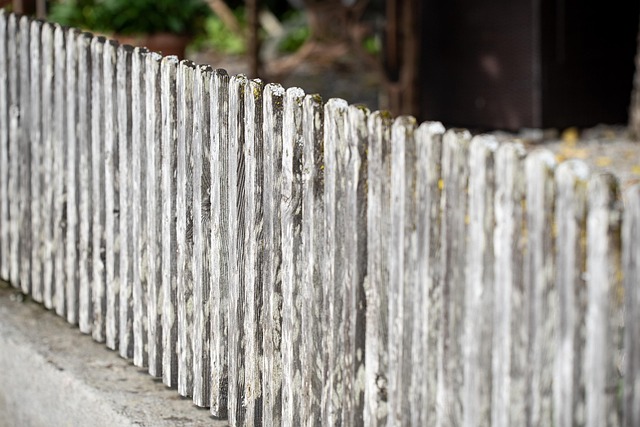In coastal regions, where harsh weather conditions and salt air pose unique challenges, durable wooden fencing is a popular and aesthetically pleasing solution. This article explores the intricacies of selecting and maintaining robust wood fence systems designed to withstand the rigors of coastal environments. From understanding the specific challenges to choosing the ideal wood species, installation considerations, maintenance tips, and enhancing aesthetic appeal, we provide a comprehensive guide to ensure your wooden fence thrives in these demanding conditions.
- Understanding Coastal Fencing Challenges
- Benefits of Durable Wooden Fencing
- Choosing the Right Wood Species
- Installation Tips for Coastal Conditions
- Maintenance and Longevity Secrets
- Esthetic Appeal in Coastal Environments
Understanding Coastal Fencing Challenges
Coastal areas present unique challenges when it comes to fencing due to their harsh, often unpredictable, environments. Salty air, frequent rainfall, strong winds, and potential exposure to sunlight can deteriorate conventional fencing materials over time. Traditional wooden fences may not hold up against these elements, leading to regular maintenance or premature replacement.
Additionally, coastal landscapes often feature uneven terrain, steep slopes, or marshy areas, making traditional fencing installation difficult. Durable wooden fencing for these regions needs to be robust enough to withstand the elements and structurally sound to navigate such terrains. It must also be aesthetically pleasing, blending seamlessly with the coastal environment, without compromising its longevity.
Benefits of Durable Wooden Fencing
Durable wooden fencing offers an appealing and functional solution for coastal areas, providing a range of benefits that cater to the unique challenges of these environments. One of its key advantages is aesthetics; wood naturally blends with coastal landscapes, adding warmth and character to properties while enhancing overall curb appeal. This natural material also provides excellent insulation, mitigating the extreme temperatures often experienced near the coast.
Moreover, durable wooden fencing is a sustainable choice. It can be sourced from managed forests, ensuring a consistent supply without damaging ecosystems. Unlike some synthetic materials, wood is recyclable and biodegradable, making it an eco-friendly option. Additionally, well-maintained wooden fences have a long lifespan, outperforming many other materials in harsh coastal conditions, thus reducing the need for frequent replacements.
Choosing the Right Wood Species
When selecting wood for coastal fencing, understanding the unique challenges posed by the environment is key. Salty air, frequent moisture, and exposure to UV rays can significantly impact the durability of your fence. Choosing the right wood species is a strategic move towards ensuring longevity and minimal maintenance.
Hardwoods like cedar, redwood, and teak are popular choices due to their natural resistance to decay, insects, and mold. These woods have a higher oil content that repels water and salt, making them ideal for coastal settings. Softwoods, while cheaper, may require more frequent treatment to withstand the coastal environment.
Installation Tips for Coastal Conditions
When installing durable wooden fencing in coastal areas, there are several tips to consider due to the unique environmental conditions. First, ensure that the chosen wood is properly treated for moisture resistance. Coastal regions often experience high humidity and regular rainfall, so using pressure-treated or naturally resistant woods like cedar or teak is ideal. Additionally, proper drainage is essential to prevent water accumulation around the fence, which can lead to rot and damage over time.
During installation, elevate the fence posts slightly above ground level to allow for natural expansion and contraction without putting stress on the wood. Use concrete foundations that provide stability and support against potential strong winds and storms. Regularly inspect and maintain the fence, sealing any gaps or cracks promptly to keep water out and ensure its longevity in these challenging conditions.
Maintenance and Longevity Secrets
Maintaining durable wooden fencing in coastal areas requires a dedicated approach to ensure longevity. Regular cleaning with mild detergents and water is essential to remove salt buildup, which can damage the wood over time. A thin layer of high-quality sealant applied annually will protect against moisture and UV rays, preserving the fence’s integrity.
Additionally, ensuring proper drainage around the fencing is crucial. Installation should slope away from the structure to prevent water accumulation. Repairs should be addressed promptly, as even small cracks can expose the wood to accelerated deterioration. By combining these maintenance practices with high-quality materials, wooden fences can withstand coastal elements for decades.
Esthetic Appeal in Coastal Environments
In coastal areas, where natural beauty and harsh environmental conditions coexist, choosing the right fencing material is paramount. Wooden fences, specifically durable, weather-resistant varieties, offer a unique blend of functionality and aesthetic appeal. Unlike their plastic or metal counterparts, wooden fences can seamlessly integrate with the surrounding landscape, enhancing the coastal environment rather than detracting from it. The warmth and texture of natural wood complement the ever-changing colors of the sea and sky, creating a harmonious atmosphere.
The beauty of wooden fencing in these regions goes beyond mere aesthetics. It provides an opportunity to embrace and celebrate the local ecosystem. Darkened by the salt air, weathered by the waves, and shaped by the wind, wooden fences can become living artifacts that tell the story of their coastal setting. This natural process enriches the landscape, attracting both locals and visitors who appreciate the enduring charm and unique character that durable wooden fencing brings to these picturesque environments.
